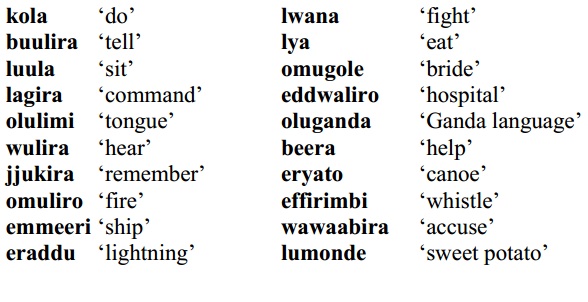Phonology Practice
- What natural class can distinguish the segments on the left from the segments on the right? (You don’t need to worry about providing this in terms of features, but be sure to think of the natural classes discussed in the phonology chapter, not just voicing, manner, and place).
- [i u], not [a e]
- [p t k], not [b ʃ n]
- [s ʃ tʃ z], not [ f l m]
- [l n t], not [ p m k]
- Now that you have had some practice describing natural classes, use that same method to write out the rules below. Remember to leave your description broad enough to describe the segments in question, but also specific enough to exclude the segments that are not involved in the rule:
- /p t k/ (but not /tʃ ʃ n/) →[b d g]
- /ɛ ɪ/ (but not /ɔ ʊ/) →[e i]
- /p b/ (but not /t d k g/) → [f v]
- Phonology Practice Problem: Ganda
- Note: /r/ is a voiced alveolar trill.

- Compare the segments /r/ and /l/. Write out the phonetic symbol and the place, manner, and voicing of each. Write two T-diagrams, showing the surrounding environments for each. (Note: Be sure to write down an entry for every time each segment appears! You might need to write more than one entry per word listed.)
- Do the segments in question have distinct or non-distinct environments? Are they in complementary or contrastive distribution? Does this mean that they belong to the same or separate phonemes?
- If they are distinct environments, describe the conditioning environment for each. If they are non-distinct environments, provide examples of (near-) minimal pairs. What phoneme(s) do you hypothesize they belong to?


University Operator: (919) 962-2211 | © 2024 The University of North Carolina at Chapel Hill |